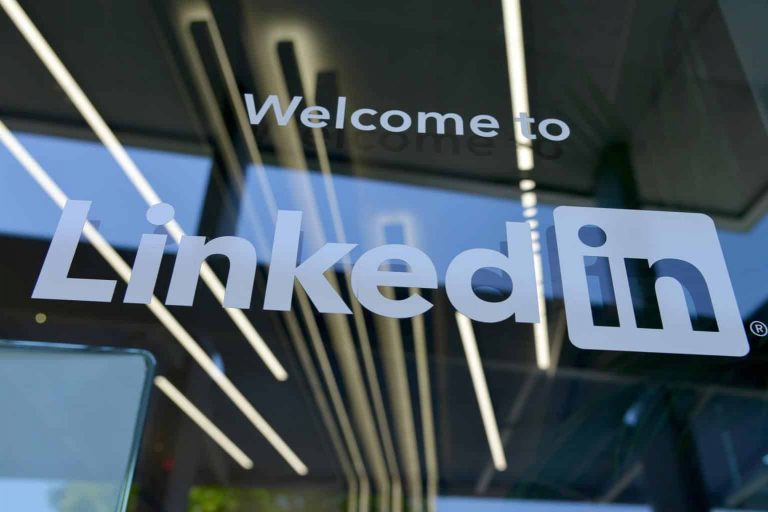
A lot of ink has been spilled over the value of advertising on social media platforms like Facebook & Twitter, Instagram, and, even the newest of shiny objects, TikTok. After all, these are among the largest online forums for social advertising and lead generation. Certainly, for B2C companies these other networks are excellent sources of engagement with customers. But what about marketing for B2B companies? Target audiences are often much busier, and they are spending corporate money rather than an individual’s annual revenue. LinkedIn continues to be the most popular hangout for upper-level corporate staff with decision-making capabilities, and should not be overlooked in your professional network marketing mix, even for B2Cs that are targeting wealthy individuals. LinkedIn lead generation has become a successful tactic for many businesses. I hope that these LinkedIn statistics for business will help you see how much potential LinkedIn has for your marketing and overall business goals.
What is really interesting is that most social media marketers today would argue that organic content visibility is highest on Instagram and LinkedIn. In fact, I have clients who consistently receive more impressions from their LinkedIn Company Page posts than the amount of followers that they have on any social network! Read on for some compelling LinkedIn statistics that will surely change your mind about how you see the platform!
LinkedIn Demographic Basics
If you’re in marketing or the corporate suite, chances are you know what LinkedIn is and you’ve been on the platform for a long time, if not utilizing it on a daily basis for everything from job applications to networking. After all, this network was designed for professionals in 2003. One of its key design characteristics is that you need a real world connection of some sort in order to connect to someone. Either you’ve known them as friends, worked with them, or attended school together. You can also have someone else introduce you. Followers, on the other hand, can be total strangers with no common connections. This is great, because it means there is less opportunity for internet users spamming or stalking people.
But this design also means that:
1. There are only 950 million users. (source)
I say “only” because this is in huge contrast to Facebook and its 2 Billion users. LinkedIn isn’t one of the social platforms used to share funny stories or find out about the latest technology toys; it is primarily a business social media platform. And since you can’t use LinkedIn to “find friends,”share wedding photos, or play games, the only real reasons to join the network are business-related–a fact that significantly impacts LinkedIn demographics.
2. LinkedIn has members in 200 countries and regions worldwide (source)
LinkedIn is far from a tiny platform, and is not relegated to North America alone; instead, the platform boasts members in 200 different countries and regions around the world, making it possible to source high-quality leads and connections from a variety of areas, rather than focusing attention on a single region or area. This is valuable, because it can help make connections you may not have thought to make on your own, and can help bring some different perspectives to the table. Its reach also makes it an effective channel for building your network and increasing the range of your audience, as it allows you to tap into markets and gain insights that may not be feasible if you are operating within your country of origin, alone.
With that said,
3. 48% of its users are active monthly. (source)
Even though this is a much smaller percentage than you see on Facebook (most active users log in at least once a month) and other social networking sites, it still means that worldwide over 310 million people log in each month, from mobile users to desktop users. And remember: LinkedIn’s user base is made up of business professionals, generally speaking. Children and retirees aren’t likely to have an active profile, although LinkedIn for students is a small but growing demographic. It is generally safe to say that active users have money to spend and your conversion rate may see higher numbers on LinkedIn than other social platforms.
Lastly, you should note that:
4. 2 new accounts are created every second. (source)

This means that, although the LinkedIn market is more limited, the network is continuing to grow with a specific type of social traffic. With an overall professional focus, we can only infer that these new members are primarily career-focused individuals. They might be job seekers, recruiters, or occupants of the C-suite, but LinkedIn traffic cares about where their careers are going.
5. Almost 60% of LinkedIn’s users are between 25 and 34 years old (source)
This is a huge number of young professionals who are looking to make their way in the job market, make connections, and get their name out there. From B2B content marketers to the entry-level worker at a startup, LinkedIn plays host to a variety of professionals who are often well-versed, but necessarily fully established, or wholly married to their current positions. Unlike many other social media channels, where the focus is on personality and appearance as much as content, LinkedIn is specifically used for business, which means that users can connect based on more substantive business goals, rather than having to focus primarily on initial appearances, follower count, and similar metrics.
6. About 20% of users are between 18 and 24 (source)
Coming in next are users between 18 and 24. Again, unlike the standard platforms people peruse on their mobile devices, LinkedIn users are there to connect, grow their network, and potentially post and search for work. Even in a demographic often charged with posting too regularly or sharing too much, a LinkedIn post is not going to be a source of spam on your profile or among your connections; instead, even among a younger group of people, you can expect to see young professionals, people looking to develop connections and grow relationships within their niche, and flourish alongside their peers.
7. 56.3% of LinkedIn users identify as men, with 43.7% identifying as women (source)
It is close to an even split between men and women on LinkedIn, which can be a great demographic to keep in mind when you are networking, searching for new connections, and posting jobs. Knowing that your audience is close to being an even split can help inform the number of people you reach out to, and can even potentially mean that your connections are more thoroughly balanced. When creating courses, preparing connections requests, or even just interacting with your connections and followers, rest assured that your content should be geared toward a (close to evenly) split demographic.
LinkedIn is Also Good for Business
LinkedIn is more than a social profile; it is a way to demonstrate your authority in your market, network and make connections, and build trust among your network and followers. LinkedIn posts can be used to establish your authority by offering insight into a specific issue or problem, connections can help increase your audience reach, and the network can even help you determine what your competitors are doing and what does or does not work for them. It is a popular platform for businesses for a reason, after all! How exactly is LinkedIn good for business? For starters,
8. More than 63 million companies are listed on LinkedIn (source)
If you are not among the 58 million companies listed on LinkedIn, you may be missing out on some key user demographics and lacking social media users who utilize LinkedIn to better understand or familiarize themselves with brands and companies. Content impressions on the site are important, and businesses would do well to make sure that they are using LinkedIn to its full potential to separate themselves from other businesses on the platform.
9. Brands have seen a 33% increase in purchase intent resulting from ad exposure on LinkedIn (source)
Although all social media platforms offer ad space, LinkedIn ads are particularly effective; LinkedIn found that B2B marketers saw a 33% increase in purchase intent, which is a huge leap! Using LinkedIn as not only a networking site, but also as a platform on which to place ads can be a huge boon for your business, and improve the likelihood of seeing a return on your marketing investment. Whether that intent actually leads to a sale is not necessarily the point: an increase in purchase intent means that your connections and followers may loop back around to your business when it comes time to make a purchase.
Further Reading: LinkedIn Ads Manager: The Definitive Guide
10. Marketers see up to 2x higher conversion rates on LinkedIn (source)
Conversion rates are the name of the game in marketing, and seeing a 2x higher conversion rate is one of the simplest reasons to invest time and energy in LinkedIn. LinkedIn is a unique animal, in that it provides the gratification of social media, but the professionalism of a site geared toward businesses. People on LinkedIn, from businesses to individuals, can turn to LinkedIn to make purchasing decisions based on a company’s reliability and perceived authority, which can make those purchase decisions feel far better informed and safe. LinkedIn is a tool for businesses that most brands and companies cannot afford to sleep on.
Further Reading: Social Media Lead Generation: LinkedIn vs Facebook
Want High-End Customers? LinkedIn is THE Place.
Of course, “high-end” is an interesting term, so let me explain. For the sake of our discussion, it is customers who have a lot of money, high levels of education, or a high-powered career. A college graduate will be more likely to spend, as will someone with an established career–both of whom are more likely to be counted among LinkedIn demographics. These people have more money to spend on goods and services, and tend to care about their reputations.
Here’s the type of customer you’ll find on LinkedIn:
11. Among Americans with a college degree, 51% use LinkedIn. (source)


Although this LinkedIn statistic is USA-specific, studies do show that this is not unusual worldwide. Professionals with higher levels of education are more likely to have a LinkedIn profile than their lower-wage, less-educated peers, making LinkedIn a valuable platform if your target audience is a more highly-educated population.
12. 71% of LinkedIn users have incomes of $50,000 USD or more. (source)
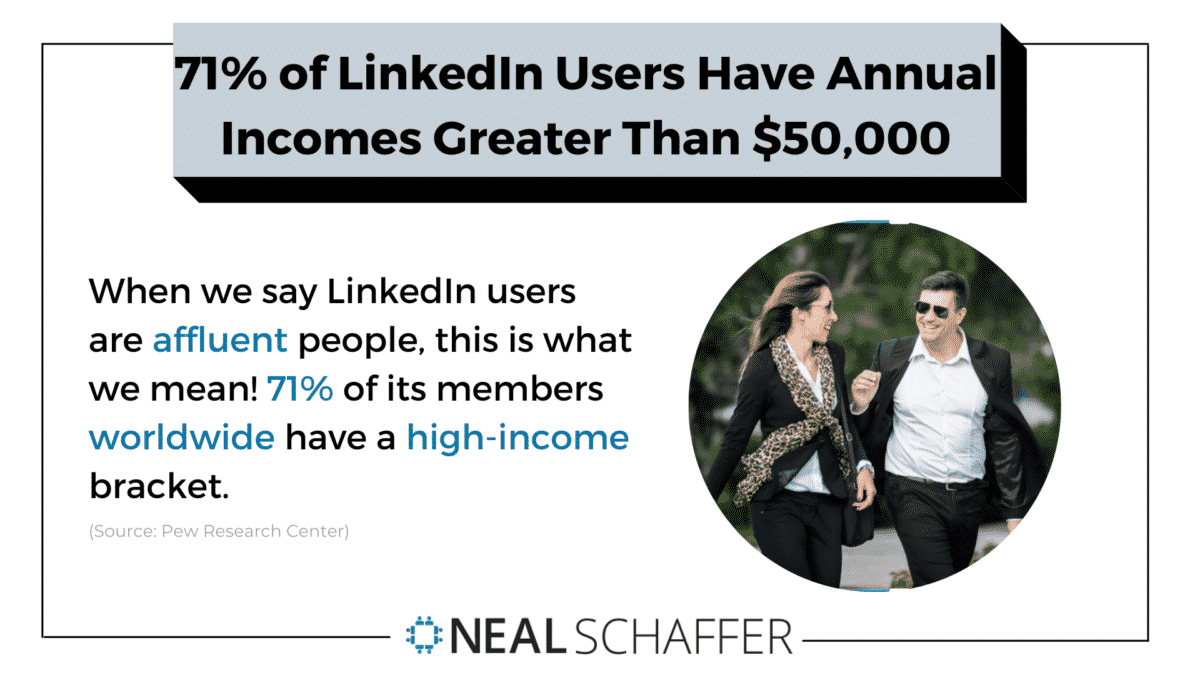

This is higher than the average American salary, and the statistic above covers worldwide LinkedIn statistics. In other words, even considering users from lower-income countries, the average LinkedIn user’s income is quite high. People in these income brackets are at least middle class in wealthy countries, and well-to-do in developing nations.
13. 41% of millionaires have a LinkedIn account. (source)


There’s a good reason for this. In addition to the “trust fund kids” and others with inherited wealth, many millionaires are high-level corporate executives and people with similar backgrounds and a similar target audience. These are exactly the sort of professionals who love LinkedIn the most.
Corporate Decision Makers? THIS is Where to Find Them.
If you’re trying to sell goods and services to other businesses, this is one of the best social network locations to target. After all, with a professional focus comes a larger concentration of corporate decision makers within social traffic. These can be purchasers, executives, or even recruiters hoping to make a positive impact on their company.


Let’s break this down:
14. There are 90 million senior-level influencers on LinkedIn. (source)


These influencers are the thought leaders of business. They help other people get a sense of what they should buy, read, and consume in a business context. Many of them, of course, are also high-up business leaders themselves. Examples include Bill Gates and the late Steve Jobs.
15. There are 65 million decision-makers on LinkedIn. (source)
Put another way, LinkedIn demographics indicate that 10% of LinkedIn users have some form of decision-making capabilities at their companies. Even in the absence of high-level decision makers, low-level human resources employees can have considerable influence on what direction a company takes, and what products or services are purchased. After all, there are lots of commercial tools available for those who make hiring determinations. And of course, human resources helps recruit managers. Want to sell employee benefits? Human resources personnel are often the ones to reach.
16. At least 10 million corporate executives have accounts. (source)
Want to put something out there for these executives to find, without the secretary getting in the way? LinkedIn ads, question posts, or relevant content are great ways to do it. Although these executives are typically very busy people, they tend to check their own social media accounts. Get an impression in the right place–i.e. via LinkedIn traffic–and they’re all ears.
LinkedIn is THE Key to Business Buying Decisions.
It almost goes without saying, but decision makers do their research before deciding on a course of action. This could mean doing due diligence on a potential new hire, or asking around for the best solution to their problem. It also means ensuring that the products and services purchased are the best ones to fit the needs of their business.
That’s why:
17. 45% of those who read articles on LinkedIn are management-level employees. (source)


These are the people who do most of the buying. While a line manager might request certain specific things from higher-ups, or be sent to Staples for a basic office item, as a rule those who make large-ticket purchases are higher up in the company.
18. Among B2B websites, including blogs, more than 50% of social media-related clicks are from LinkedIn. (source)
What this means in practical terms is that LinkedIn is a major place where managers look for information on business-related products and services. If you aren’t advertising here, you’re missing out on a lot of potential referrals and user growth.
If that isn’t enough to convince you that LinkedIn is important, consider:
19. LinkedIn says that decision-makers read an average of 10 articles before buying something. (source)
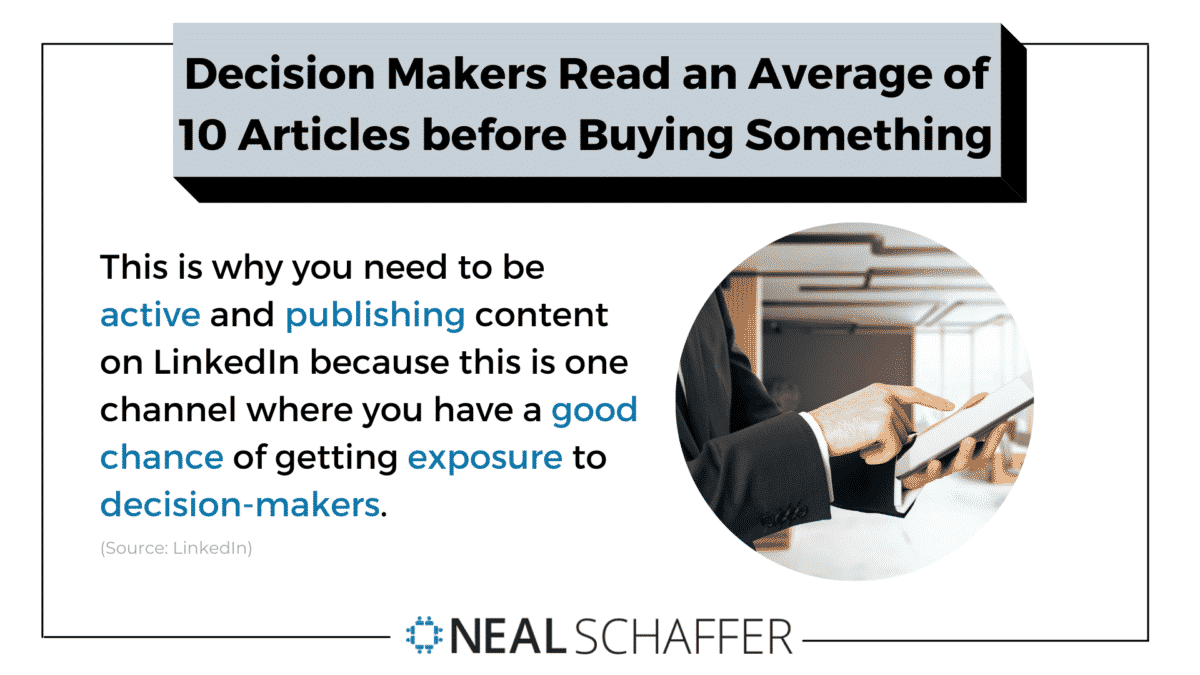

That’s a lot of content, and it shows that stakeholders like to know as much as possible about their options before choosing one. Whether that’s influencer content like blog posts or explanations of a product from the manufacturer, it needs to be where the decision-makers will see it.


20. 73% of professionals trust LinkedIn for information. (source)


Why? On scores regarding reliability of information, management of user information, and the likelihood of being able to share content that is up-to-date, relevant, and well-researched, LinkedIn came out on top over competitors like Facebook and Twitter. Also, businesses generally put their names directly on content published through LinkedIn. What I mean is that it’s their own brand of content, rather than something sponsored and put out there by just anybody. It’s written or produced by marketers specifically for decision makers to know what a company has to offer.
21. 96% of executives turn to LinkedIn as their preferred content source. (source)
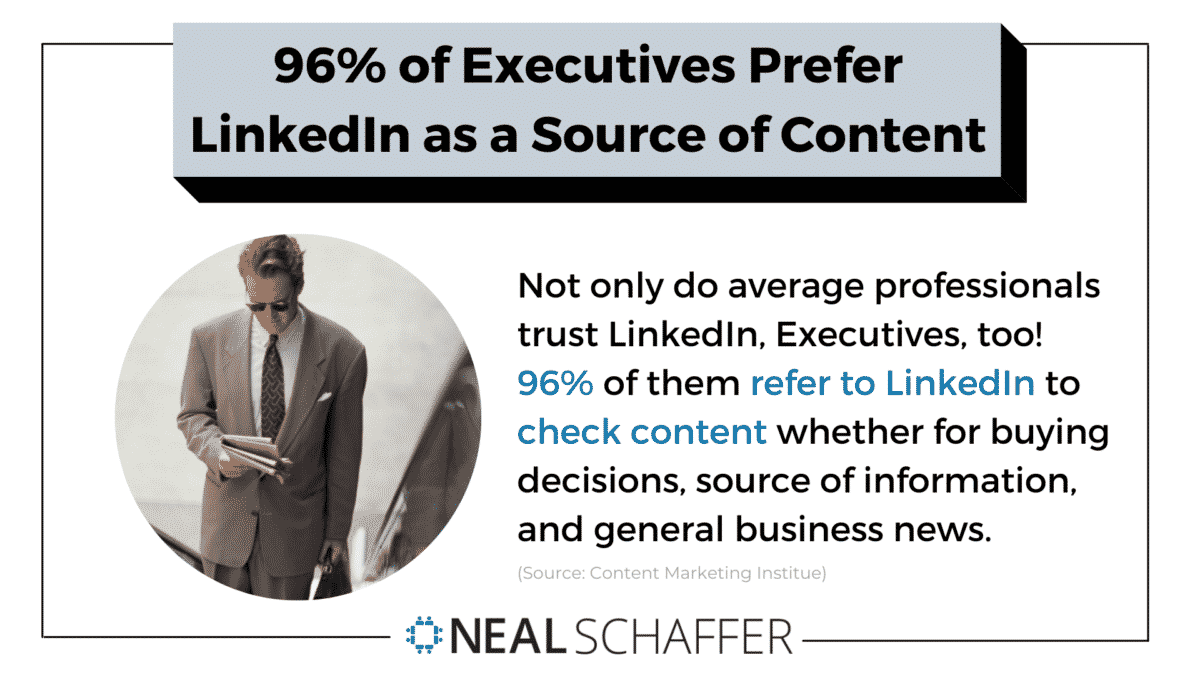

Remember, the higher up the chain of command in a company, the more power that person has to make buying decisions. And it stands to reason that they’re the ones who make the decision on really big purchases. For example, the CIO might be the person who signs off on the purchase of 100 new desktop computers for the staff.
22. In B2B sales, 80% of social media-related quality leads come from LinkedIn. (source)


Given that so many executives use LinkedIn as a research source, this isn’t really a surprising find in LinkedIn advertising statistics. In just a few minutes, busy professionals can read up on industry trends, groundbreaking innovations, and popular products for business. If they’re consuming so much content here, it’s no wonder that decision makers click on links here or cite LinkedIn as their source of leads when talking to sales.
Want Highly Visible Content? That’s LinkedIn’s Specialty.
If you’re like most B2B marketing professionals, you want content that will stand out above the crowd to reach individual users and increase the engagement rate of your advertising audience. After all, in order for your carefully-prepared articles to reach the right sets of eyes, it needs to not be lost among the beauty product reviews and model-building tutorials found among the larger user base found on other social media sites. That’s why LinkedIn is such a great place to publish your content: it’s mostly for business purposes, so a significant percent of users go there to see and be seen.
Consider these LinkedIn statistics for your LinkedIn content strategy:
23. Over 130,000 articles are published through LinkedIn every week. (source)


That’s a lot of pieces of content uploaded, but not nearly the number of those produced on other platforms. One reason for this, of course, is that LinkedIn has specific rules on what can and cannot be published there, and those rules are enforced. They’ve made it clear that this isn’t the place for discussing hobbies or the latest celebrity gossip, for example. What does this mean? Those 130,000 business articles don’t have to compete with other types of content for attention and may reach more monthly users than their competitors.
24. LinkedIn is the 31st most visited website in the world. (source)
Granted, Facebook and Youtube are more popular, but they’re also really crowded when it comes to published content. Also, these other social sites aren’t publishing such a large percentage of business-related material. Certainly Youtube is a great place to put business-related “how-to’s,” but that isn’t the same thing as an article that can get indexed as text, making LinkedIn a highly effective platform for B2B marketing.
25. The best content publishers see a 120% growth in page followers each year. (source)


The implications of utilizing LinkedIn as part of your content marketing strategy should be obvious: people are searching out quality content on LinkedIn. To be sure, getting your LinkedIn articles indexed by Google will help with page views a bunch. After all, people don’t exactly spend a ton of time on LinkedIn every day, as even monthly users are lower on LinkedIn than on other sites. But it also means that business decision makers are willing to spend the time to read relevant material on this unique marketing platform.
Further Reading: 5 Things to Keep in Mind to Use LinkedIn as a Blogging Platform
Some Types of LinkedIn Content are More Effective Than Others
Like with most platforms, not all marketing efforts are created equal. It’s important to remember that on LinkedIn, your target market as a rule is busy professionals who don’t have time to sift through the clutter. So, what do we know about the effective use of this platform?
26. LinkedIn content has an average engagement rate of 3.16%. (source)


While many consider TikTok and Instagram to have the highest engagement in social media, it’s time to readjust your expectations: LinkedIn content has an average engagement rate above 3%, with using video content often returning an engagement rate above 4%.
However, as the study linked above from Socialinsider indicates, large LinkedIn accounts can achieve average engagement rates of over 4% by posting images and native documents, rather than videos.
Further Reading: 7 Ways and 12 Best Practices to Use LinkedIn Polls for Marketing (with Examples)
27. The average LinkedIn user spends less than 7 minutes on the site. (source)


An average of less than 7 minutes spent on the site means that LinkedIn users need easy-to-access information, presented in a clear and concise way. While LinkedIn may have once been seen largely as a recruitment platform, it has grown into a messaging platform, social media marketing platform, and even a news platform. When constructing your LinkedIn content, make sure it can be consumed and understood within the time frame allotted by most users.
28. Including a link increases engagement by 200%. (source)
Let’s face it, nothing invites people to your website by posting a link to it. If they have to Google your company name, it eats up valuable decision maker time. Plus, it’s well known that posts get shared when they’re seen as useful, and having links to relevant websites increases the value of your post. Even when you are using LinkedIn stories, make use of relevant links.
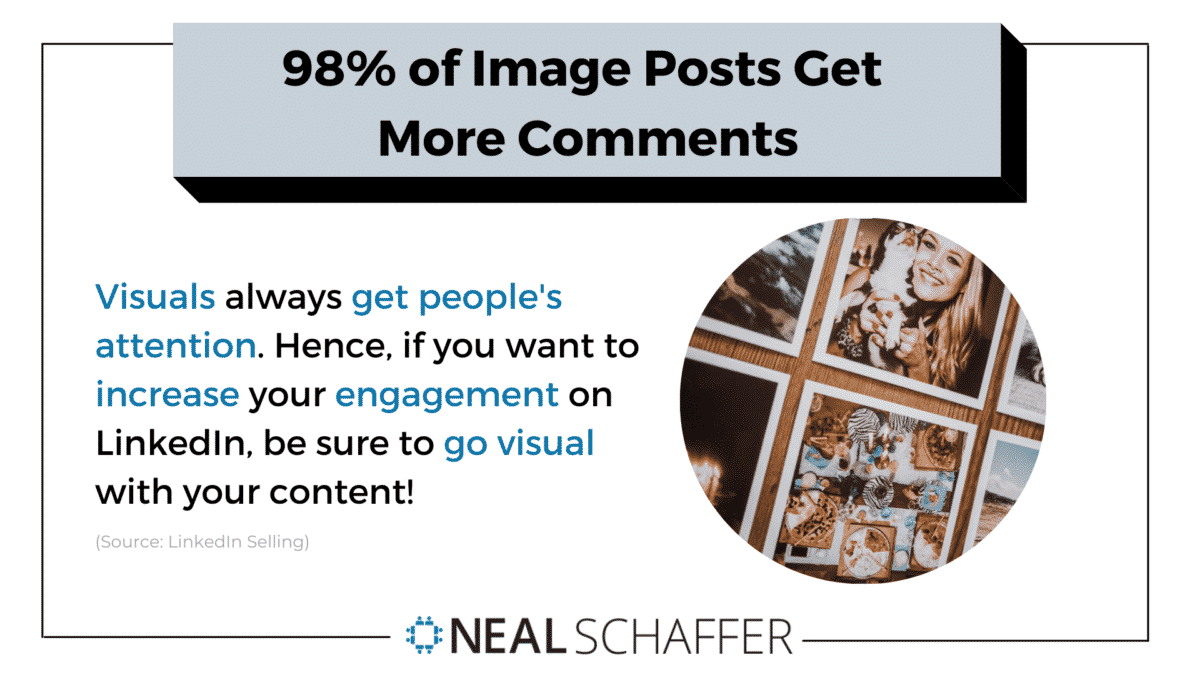

People love visuals, whether that’s graphs, illustrations, or infographics. These either put information into a concise format, or allow the viewer to see things in a different way. For instance, bar graphs allow proportions to be more obvious. Plus, this type of content can be reused for presentations, such as when a new product is being explained to employees. This adds value to your social media marketing strategy without it being more expensive.
That being said…
30. Long-form content is the most shareable. (source)
One study shows that the content that goes viral is mostly long-form content. Given how busy professionals on LinkedIn are, this might seem surprising. However, long articles give potential customers a chance to learn more about your product or service. When this is helpful to someone, they’re likely to share it with others in the same industry.
31. LinkedIn boasts 63 million unique users viewing on mobile devices. (source)
When creating content and even your company profile, it is vital to make sure that content is mobile friendly. From making sure your images can be viewed appropriately on a small screen, to ensuring that your list posts and paragraphs are structured in a way that is easy to utilize on a phone or tablet, mobile-friendly content is as critical to LinkedIn as it is to other social networking platforms today.
If you’re involved in B2B marketing, it’s hard to argue that there are many channels more valuable for reaching customers than LinkedIn. Members tend to be highly educated, well-placed in business and able to influence buying decisions.
Further Reading: 15 LinkedIn Marketing Strategy Tips to Grow Your Business on LinkedIn
Hero photo by Greg Bulla on Unsplash
LinkedIn Statistics FAQs
Your statistics on LinkedIn are accessible from the LinkedIn analytics dashboard. Your dashboard analyzes three sections of your LinkedIn page; your activity dashboard, post analytics, and profile analytics. The activity dashboard gives qualitative insights into your likes, comments, mentions, and share. Meanwhile, LinkedIn Post Analytics provides a comprehensive report of your content, and LinkedIn Profile Analytics tracks your profile progress.
No, LinkedIn is not losing popularity. In fact, comparing the numbers from the previous years, LinkedIn users have grown to nearly 800 million users — and they continue to grow. The number might not be close to Facebook’s active users, but remember that LinkedIn’s market has an overall professional focus. The platform is just continuously changing.
LinkedIn has remained and will remain popular. After all, people go to LinkedIn to do business, find job opportunities, connect with other professionals, and grow their network. Hence, LinkedIn users will always have a reason to use the platform due to its nature.
Yes, LinkedIn has analytics. It is available to all users but may differ depending on account type. Premium users have access to more analytics than free accounts. Some of the analytics you may find are:
1. Who visited your profile.
2. Number of search appearances
3. Content Analytics
4. Followers Analytics
Actionable advice for your digital / content / influencer / social media marketing.
Join 13,000+ smart professionals who subscribe to my regular updates.
Source:Neal Schaffer , nealschaffer.com, [publish_date
Source Link